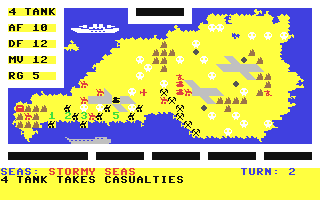|
This
reconstruction of one of the bloodiest battles of WWII's
South Pacific campaign is the latest in the Strategic
Wargames Series begun with Falklands 82. It uses
a system similar to that of its predecessor, with full
map display at all times, five levels of difficulty,
phased order sequences and a game design that follows
in PSS's philosophy of 'playable' games (ie ones that
do not take more than a couple of sessions to complete).
As with Falklands, the author (James Bethell,
who wrote both games) has willingly sacrificed some
authenticity for the sake of playability. There is logic
to this move. A detailed simulation of the conflict
would definitely have strained the limits of a disk
based game, let alone one on cassette. The game still
tries to cover the battle in reasonable depth.
The
package is simple, consisting of a small cassette case
and booklet of instructions. Loading takes no more than
a couple of minutes (which is a shame as the loading
screen is a very good rendition of the planting of the
US flag on the beach at Iwo Jima). Once the game has
loaded, the first of the aesthetic improvements to Bethell's
game system becomes noticeable. Everything is joystick
driven. In a wargame there's no reason why this cannot
always be the case, as the increase in the speed of
interaction between player and computer allows straightforward
implementation of a strategy, instead of having to put
ideas through a needlessly muddled series of arbitrary
keyboard interactions.

All
the game functions, from selecting difficulty, selecting
a unit to order, the orders themselves (Move, Attack,
Land, Pass), are simply selected from information windows
and confirmed by pressing the fire button. All relevant
information on the unit currently selected is also displayed
in an information window to the left of the screen.
This information is shown in an abstract points system.
Units have an aggression factor, defense factor, movement
factor, and a range factor, all of which affect combat
ability.
The
player (as there is no two-player option) must always
take the side of the American forces, with the objective
of eliminating all the enemy units between turns 32
and 36 (depending on the difficulty level set). The
enemy may fortify positions, make suicide attacks if
a unit is about to be wiped out, and launch air attacks
against the carrier force bringing reinforcements and
artillery support to your units. As long as the offshore
fleet is well defended, and weather permitting, you
may launch air strikes against the enemy.
Initially,
the player must establish a beachhead with the first
of his units (reinforcements arrive throughout the game),
and there are six beaches which may act as landing sites.
Many of them are penned in by minefields, and so a careful
choice must be made as to which units land where. As
many beaches as required may be used with the single
provision that units may not be stacked in the same
area.
That
really sums up the game. Getting into the game is an
extremely simple process, no doubt because it was designed
with beginners in mind. And this brings up the question
of why PSS include arcade sequences on their more 'serious'
games and yet not on these introductory efforts. Not
that I am advocating their use at all, but it does seem
rather strange. There is some animation in the game,
however. Air strikes by either side are rather crudely
depicted by showing a simple aircraft silhouette passing
over the target area.
There
are faults with this system. Air strikes can only be
called either after an attack by ground forces or by
a unit that deliberately tries to attack whilst out
of range. This really could have been made neater. The
limited intelligence used in the game seems to be affected
only by proximity and not by terrain. Because the designer
has decided to make the whole island visible during
play, the display size of the units
|